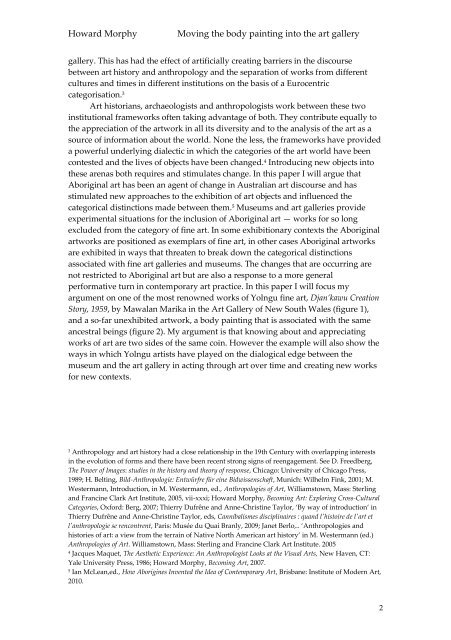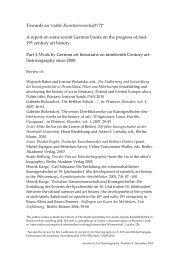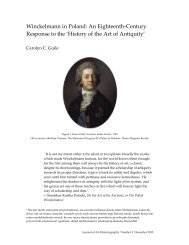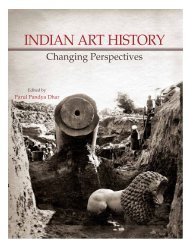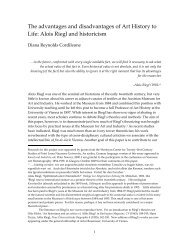Moving the body painting into the art gallery - Journal of Art ...
Moving the body painting into the art gallery - Journal of Art ...
Moving the body painting into the art gallery - Journal of Art ...
Create successful ePaper yourself
Turn your PDF publications into a flip-book with our unique Google optimized e-Paper software.
Howard Morphy <strong>Moving</strong> <strong>the</strong> <strong>body</strong> <strong>painting</strong> <strong>into</strong> <strong>the</strong> <strong>art</strong> <strong>gallery</strong><br />
<strong>gallery</strong>. This has had <strong>the</strong> effect <strong>of</strong> <strong>art</strong>ificially creating barriers in <strong>the</strong> discourse<br />
between <strong>art</strong> history and anthropology and <strong>the</strong> separation <strong>of</strong> works from different<br />
cultures and times in different institutions on <strong>the</strong> basis <strong>of</strong> a Eurocentric<br />
categorisation. 3<br />
<strong>Art</strong> historians, archaeologists and anthropologists work between <strong>the</strong>se two<br />
institutional frameworks <strong>of</strong>ten taking advantage <strong>of</strong> both. They contribute equally to<br />
<strong>the</strong> appreciation <strong>of</strong> <strong>the</strong> <strong>art</strong>work in all its diversity and to <strong>the</strong> analysis <strong>of</strong> <strong>the</strong> <strong>art</strong> as a<br />
source <strong>of</strong> information about <strong>the</strong> world. None <strong>the</strong> less, <strong>the</strong> frameworks have provided<br />
a powerful underlying dialectic in which <strong>the</strong> categories <strong>of</strong> <strong>the</strong> <strong>art</strong> world have been<br />
contested and <strong>the</strong> lives <strong>of</strong> objects have been changed. 4 Introducing new objects <strong>into</strong><br />
<strong>the</strong>se arenas both requires and stimulates change. In this paper I will argue that<br />
Aboriginal <strong>art</strong> has been an agent <strong>of</strong> change in Australian <strong>art</strong> discourse and has<br />
stimulated new approaches to <strong>the</strong> exhibition <strong>of</strong> <strong>art</strong> objects and influenced <strong>the</strong><br />
categorical distinctions made between <strong>the</strong>m. 5 Museums and <strong>art</strong> galleries provide<br />
experimental situations for <strong>the</strong> inclusion <strong>of</strong> Aboriginal <strong>art</strong> — works for so long<br />
excluded from <strong>the</strong> category <strong>of</strong> fine <strong>art</strong>. In some exhibitionary contexts <strong>the</strong> Aboriginal<br />
<strong>art</strong>works are positioned as exemplars <strong>of</strong> fine <strong>art</strong>, in o<strong>the</strong>r cases Aboriginal <strong>art</strong>works<br />
are exhibited in ways that threaten to break down <strong>the</strong> categorical distinctions<br />
associated with fine <strong>art</strong> galleries and museums. The changes that are occurring are<br />
not restricted to Aboriginal <strong>art</strong> but are also a response to a more general<br />
performative turn in contemporary <strong>art</strong> practice. In this paper I will focus my<br />
argument on one <strong>of</strong> <strong>the</strong> most renowned works <strong>of</strong> Yolngu fine <strong>art</strong>, Djan’kawu Creation<br />
Story, 1959, by Mawalan Marika in <strong>the</strong> <strong>Art</strong> Gallery <strong>of</strong> New South Wales (figure 1),<br />
and a so-far unexhibited <strong>art</strong>work, a <strong>body</strong> <strong>painting</strong> that is associated with <strong>the</strong> same<br />
ancestral beings (figure 2). My argument is that knowing about and appreciating<br />
works <strong>of</strong> <strong>art</strong> are two sides <strong>of</strong> <strong>the</strong> same coin. However <strong>the</strong> example will also show <strong>the</strong><br />
ways in which Yolngu <strong>art</strong>ists have played on <strong>the</strong> dialogical edge between <strong>the</strong><br />
museum and <strong>the</strong> <strong>art</strong> <strong>gallery</strong> in acting through <strong>art</strong> over time and creating new works<br />
for new contexts.<br />
3 Anthropology and <strong>art</strong> history had a close relationship in <strong>the</strong> 19th Century with overlapping interests<br />
in <strong>the</strong> evolution <strong>of</strong> forms and <strong>the</strong>re have been recent strong signs <strong>of</strong> reengagement. See D. Freedberg,<br />
The Power <strong>of</strong> Images: studies in <strong>the</strong> history and <strong>the</strong>ory <strong>of</strong> response, Chicago: University <strong>of</strong> Chicago Press,<br />
1989; H. Belting, Bild-Anthropologie: Entwürfre für eine Bidwissenschaft, Munich: Wilhelm Fink, 2001; M.<br />
Westermann, Introduction, in M. Westermann, ed., Anthropologies <strong>of</strong> <strong>Art</strong>, Williamstown, Mass: Sterling<br />
and Francine Clark <strong>Art</strong> Institute, 2005, vii-xxxi; Howard Morphy, Becoming <strong>Art</strong>: Exploring Cross-Cultural<br />
Categories, Oxford: Berg, 2007; Thierry Dufrêne and Anne-Christine Taylor, ‘By way <strong>of</strong> introduction’ in<br />
Thierry Dufrêne and Anne-Christine Taylor, eds, Cannibalismes disciplinaires : quand l'histoire de l'<strong>art</strong> et<br />
l'anthropologie se rencontrent, Paris: Musée du Quai Branly, 2009; Janet Berlo,.. ‘Anthropologies and<br />
histories <strong>of</strong> <strong>art</strong>: a view from <strong>the</strong> terrain <strong>of</strong> Native North American <strong>art</strong> history’ in M. Westermann (ed.)<br />
Anthropologies <strong>of</strong> <strong>Art</strong>. Williamstown, Mass: Sterling and Francine Clark <strong>Art</strong> Institute. 2005<br />
4 Jacques Maquet, The Aes<strong>the</strong>tic Experience: An Anthropologist Looks at <strong>the</strong> Visual <strong>Art</strong>s, New Haven, CT:<br />
Yale University Press, 1986; Howard Morphy, Becoming <strong>Art</strong>, 2007.<br />
5 Ian McLean,ed., How Aborigines Invented <strong>the</strong> Idea <strong>of</strong> Contemporary <strong>Art</strong>, Brisbane: Institute <strong>of</strong> Modern <strong>Art</strong>,<br />
2010.<br />
2


